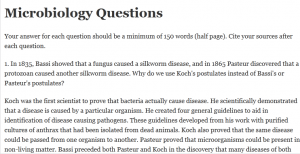Microbiology Questions

Your answer for each question should be a minimum of 150 words (half page). Cite your sources after each question.
1. In 1835, Bassi showed that a fungus caused a silkworm disease, and in 1865 Pasteur discovered that a protozoan caused another silkworm disease. Why do we use Koch’s postulates instead of Bassi’s or Pasteur’s postulates?
Koch was the first scientist to prove that bacteria actually cause disease. He scientifically demonstrated that a disease is caused by a particular organism. He created four general guidelines to aid in identification of disease causing pathogens. These guidelines developed from his work with purified cultures of anthrax that had been isolated from dead animals. Koch also proved that the same disease could be passed from one organism to another. Pasteur proved that microorganisms could be present in non-living matter. Bassi preceded both Pasteur and Koch in the discovery that many diseases of both man and animal were caused by parasites. This was vital in the formulation of the germ theory, to which both Pasteur and Koch would later expound. Bassi and Pasteur, though their research was important to later research, did not discover the true cause of disease, nor were they able to isolate the causal organisms. Koch was not only able to isolate the causal pathogen, he was able to correlate a specific pathogen caused a specific disease. We use his postulates because, if followed, they provide accurate data.
2. In 1884, Hans Christian Gram described a method of staining bacterial cells while not staining surrounding animal tissues; however, he thought the staining method he developed was faulty because not all bacteria stained. In a letter to the editor of the journal in which Gram published his findings, write your response to Gram’s concern.
3. Compare and contrast gram-positive and gram-negative cell walls with regard to (a) sensitivity to antimicrobial agents, (b) resistance to phagocytes, (c) chemical composition, and (d) decolonization by alcohol.
4. Identify the catabolic pathways used by the following bacteria:
Pseudomonas Oxidizes glucose
Lactobacillus Ferments glucose
Alcaligenes Neither oxidizes nor ferments glucose
Escherichia Oxidizes and ferments glucose
5. You look in the refrigerator and find an orange drink you had forgotten was there. The drink now has an off-taste and it bubbles. What is the most likely explanation for the changes in the drink?
6. Rhodopseudomonas is an anaerobic phototropism that uses organic compounds as an electron donor. It is also capable of chemotherapeutic metabolism. Diagram the metabolic pathways of this bacterium.
7. Assume that you are responsible for decontaminating materials in a large hospital. How would you sterilize each of the following? Briefly justify your answers.
a. A mattress used by a patient with bubonic plague
b. Intravenous glucose-saline solutions
c. Used disposable syringe
d. Tissues taken from patients